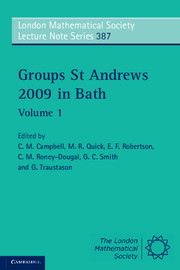Book contents
- Frontmatter
- Contents
- Introduction
- A speech in honour of John Cannon and Derek Holt
- Finite groups of Lie type and their representations
- Iterated monodromy groups
- Engel elements in groups
- Some classes of finite semigroups with kite-like egg-boxes of D-classes
- Structure of finite groups having few conjugacy class sizes
- Group theory in cryptography
- A survey of recent results in groups and orderings: word problems, embeddings and amalgamations
- A survey on the minimum genus and maximum order problems for bordered Klein surfaces
- On one-relator quotients of the modular group
- Miscellaneous results on supersolvable groups
- Automorphisms of products of finite groups
- A rational property of the irreducible characters of a finite group
- Automotives
- On n-abelian groups and their generalizations
- Computing with matrix groups over infinite fields
- Trends in infinite dimensional linear groups
- Engel conditions on orderable groups and in combinatorial problems (a survey)
- References
Group theory in cryptography
Published online by Cambridge University Press: 05 July 2011
- Frontmatter
- Contents
- Introduction
- A speech in honour of John Cannon and Derek Holt
- Finite groups of Lie type and their representations
- Iterated monodromy groups
- Engel elements in groups
- Some classes of finite semigroups with kite-like egg-boxes of D-classes
- Structure of finite groups having few conjugacy class sizes
- Group theory in cryptography
- A survey of recent results in groups and orderings: word problems, embeddings and amalgamations
- A survey on the minimum genus and maximum order problems for bordered Klein surfaces
- On one-relator quotients of the modular group
- Miscellaneous results on supersolvable groups
- Automorphisms of products of finite groups
- A rational property of the irreducible characters of a finite group
- Automotives
- On n-abelian groups and their generalizations
- Computing with matrix groups over infinite fields
- Trends in infinite dimensional linear groups
- Engel conditions on orderable groups and in combinatorial problems (a survey)
- References
Summary
Abstract
This paper is a guide for the pure mathematician who would like to know more about cryptography based on group theory. The paper gives a brief overview of the subject, and provides pointers to good textbooks, key research papers and recent survey papers in the area.
Introduction
In the last few years, many papers have proposed cryptosystems based on group theoretic concepts. Notes from a recent advanced course on the subject by Myasnikov, Shpilrain and Ushakov have recently been published as a monograph [63], and a textbook (with a rather different focus) by González Vasco, Magliveras and Steinwandt [31] is promised in 2010. Group-based cryptosystems have not yet led to practical schemes to rival RSA and Diffie–Hellman, but the ideas are interesting and the different perspective leads to some worthwhile group theory. The cryptographic literature is vast and diverse, and it is difficult for a newcomer to the area to find the right sources to learn from. (For example, there are many introductory textbooks aimed at the mathematical audience that introduce RSA. How many of these textbooks hint that the basic RSA scheme is insecure if refinements such as message padding are not used? For a discussion of these issues, see Smart [78, Chapters 17,18 and 20], for example.) Our paper will provide some pointers to some sources that, in our opinion, provide a good preparation for reading the literature on group-based cryptography; the paper will also provide a high level overview of the subject.
- Type
- Chapter
- Information
- Groups St Andrews 2009 in Bath , pp. 133 - 149Publisher: Cambridge University PressPrint publication year: 2011
References
- 2
- Cited by



